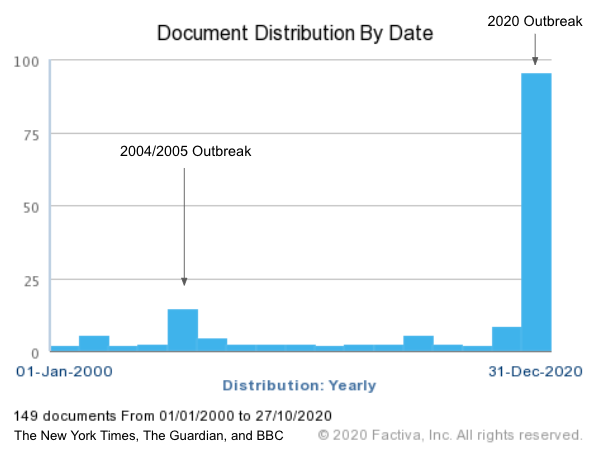Student Focus Post: Written by students from the Global Locust Initiative Lab to share their research and experience.
My name is Maddie Magrino and I am a senior at ASU studying Earth and Environmental Studies with a minor in Sustainability. I was first introduced to the Global Locust Initiative (GLI) upon taking Dr. Arianne Cease’s Sustainable Ecosystems course in Fall of 2019. I was immediately interested in the projects Dr. Cease was working on and was eager to join the GLI team to help their research. I was fortunate enough to be offered to work on a remote project comparing the media coverage of the desert locust outbreak in 2004/2005 and the outbreak in 2019/2020 alongside Clara Therville and Marie Chandelier.
Understanding the differences in media coverage over time is essential to determining how the media is able to influence the public’s perception of current events. The coverage of desert locust outbreaks in 2004/2005 and 2019/2020 differed immensely in numbers (see figure 1), but did it differ in content, verbiage and tone? Using a research database, Factiva, we collected about 150 articles from the New York Times, BBC and The Guardian, from the time periods 2000-2009 and 2010-2020.
To analyze the articles we collected, we used the data analysis software, Nvivo and lexical analysis software, TXM. After reading through each of the articles, we found that The New York Times discusses desert locust outbreaks with a scientific/informational approach, whereas BBC and The Guardian provide updates on the severity of the plague with comparisons to the outbreak a decade prior. The Guardian and BBC seek to draw out emotion from their audience to spark a level of concern toward the swarms, while the New York Times aims to have their readers understand why outbreaks are occurring. Compared to the coverage in 2000-2009, the articles collected from 2010-2020 discuss the desert locust outbreak as a threat in conjunction with Covid-19, and refer primarily to field stakeholders (local sources) for obtaining their information. During 2000-2009, most of the knowledge collected came from international and national (more institutional) sources. Moving forward, we hope to advance our understanding of how media covers desert locust outbreaks by collecting data from a wider scale of sources and analyzing articles with a systematic approach.
